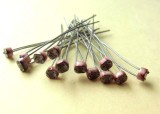Photoresistors and their parameters
 A photoresistor is a resistor made of a semiconductor's photoelectric effect, which is a resistor whose resistance varies with the intensity of incident light; the incident light is strong, the resistance is reduced, the incident light is weak, and the resistance increases. Photosensitive resistors are generally used for light measurement, light control, and photoelectric conversion (convert light changes into electrical changes). Commonly used photosensitive resistors cadmium sulfide photosensitive resistors, which are made of semiconductor materials. The resistance of the photoresistor varies with the intensity of the incident light (visible light). Under dark conditions, its resistance (dark resistance) can reach 1 to 10 M ohms. Under strong light conditions (100 LX), it has a resistance. The value (brightness) is only a few hundred to several thousand ohms. The photosensitive resistor's sensitivity to light (ie, spectral characteristics) is similar to the human eye's response to visible light (0.4 to 0.76) μm. As long as the human eye can sense light, it will cause its resistance to change. When the light control circuit is designed, an incandescent light bulb (small beads) or natural light is used as a control light source, which greatly simplifies the design.
A photoresistor is a resistor made of a semiconductor's photoelectric effect, which is a resistor whose resistance varies with the intensity of incident light; the incident light is strong, the resistance is reduced, the incident light is weak, and the resistance increases. Photosensitive resistors are generally used for light measurement, light control, and photoelectric conversion (convert light changes into electrical changes). Commonly used photosensitive resistors cadmium sulfide photosensitive resistors, which are made of semiconductor materials. The resistance of the photoresistor varies with the intensity of the incident light (visible light). Under dark conditions, its resistance (dark resistance) can reach 1 to 10 M ohms. Under strong light conditions (100 LX), it has a resistance. The value (brightness) is only a few hundred to several thousand ohms. The photosensitive resistor's sensitivity to light (ie, spectral characteristics) is similar to the human eye's response to visible light (0.4 to 0.76) μm. As long as the human eye can sense light, it will cause its resistance to change. When the light control circuit is designed, an incandescent light bulb (small beads) or natural light is used as a control light source, which greatly simplifies the design. The working principle of the photoresistor is based on the internal photoelectric effect. The electrode lead is mounted on both ends of the semiconductor light-sensitive material, and is encapsulated in a tube case with a transparent window to constitute a photoresistor. In order to increase the sensitivity, the two electrodes are often made into a comb. The materials used for making photoresistors are mainly semiconductors such as metal sulfides, selenides and tellurides. Usually, a thin photoresistor body photoresistor schematic and a comb-shaped ohmic electrode are fabricated on an insulating substrate by coating, spraying, sintering, etc., and the lead wire is connected and enclosed in a sealed housing with a light-transmitting mirror to prevent moisture influence. Its sensitivity. In the dark environment, its resistance is very high. When exposed to light, if the photon energy is greater than the band gap of the semiconductor material, the electrons in the valence band can absorb energy of one photon and then transition to the conduction band, and the valence band This produces a positively charged hole. This electron-hole generated by light affects the number of carriers in the semiconductor material, making its resistivity small, resulting in a drop in the photoresistor resistance. The stronger the light, the lower the resistance. After the incident light disappears, the electron-hole pair generated by the photon excitation will recombine, and the resistance of the photoresistor will return to its original value. A voltage is applied to the metal electrodes at both ends of the photo-resistor, and there is a current passing through the photo-resistor. When the light is irradiated by the wavelength, the current will increase with the light intensity, thereby achieving photoelectric conversion. The photo-resistor has no polarity and is purely a resistor device. It can use both DC voltage and AC voltage when it is used. The conductivity of a semiconductor depends on the number of carriers in the semiconductor conduction band.
Standard (classic) Venturi tube is a standard throttle device designed and manufactured according to GB/T2624 and certified according to GB JJG640 and needn't be calibrated.
In all standard Throttling Devices, the standard (classic) Venturi tube requires the minimum straight pipe section upstream and downstream, the minimum permanent pressure loss.
Classic Venturi Flowmeter,Venturi Flowmeter,Throttling Device Venturi Flow Meter,Venturi Flow Meter Milk Flow Meter
Kaifeng Chuangxin Measurement & Control Instrument Co., Ltd. , https://www.kfcxflowmeter.com